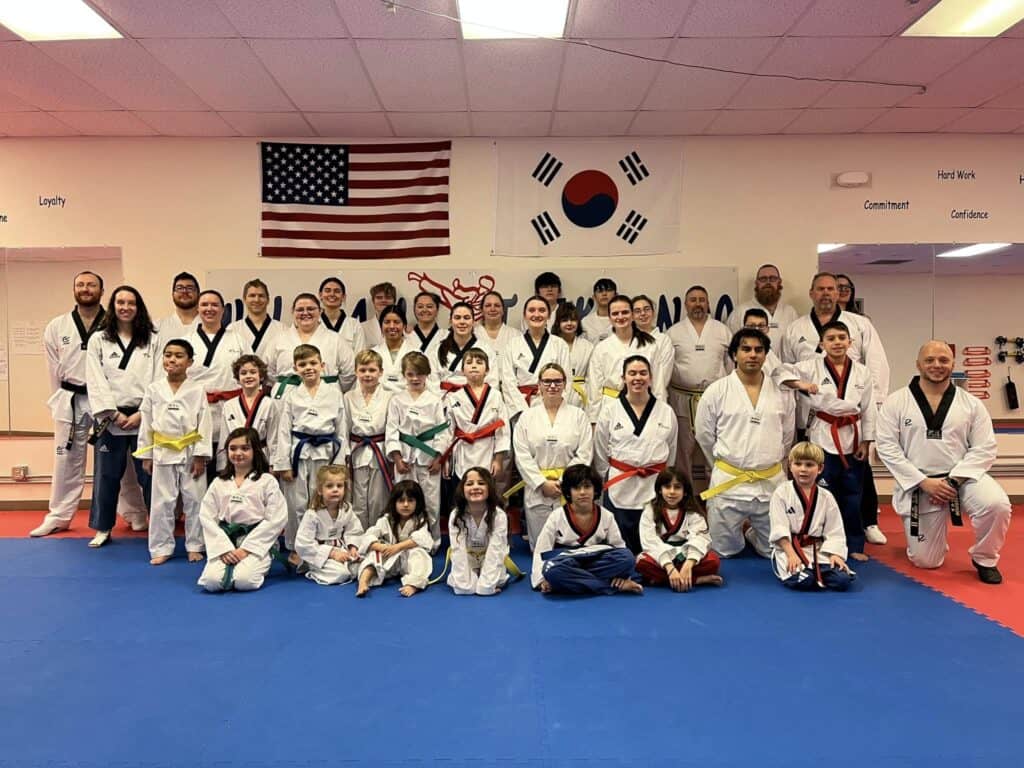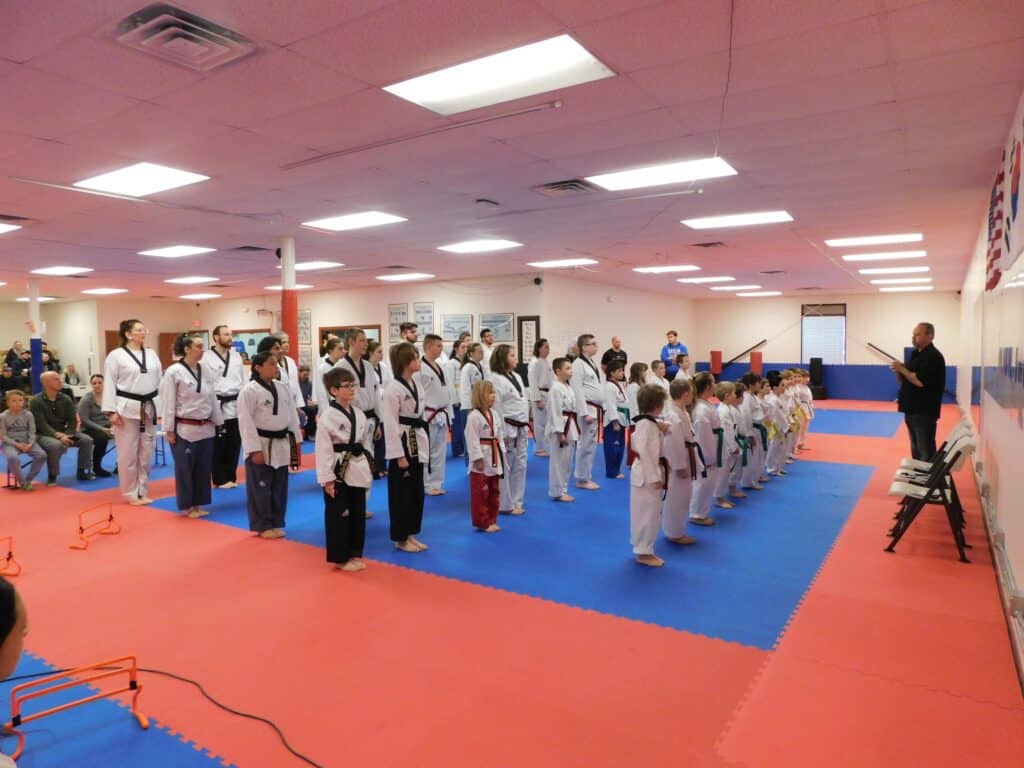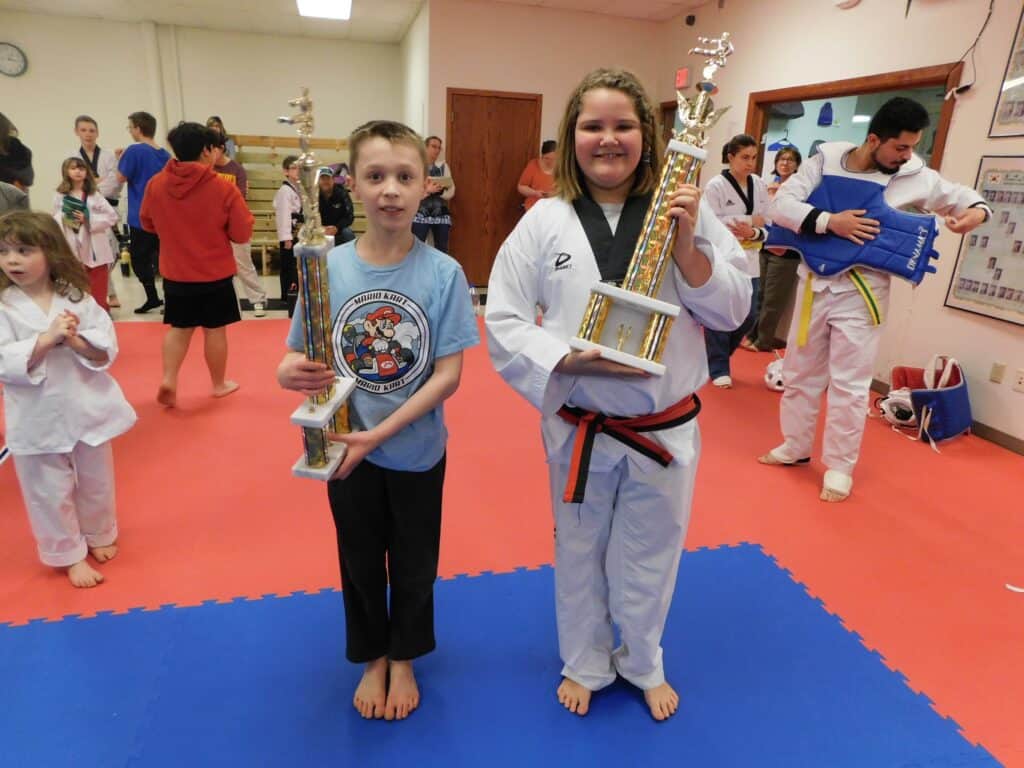
February 24, 2025
GREEN BAY – Many tales of entrepreneurship begin at home: start-ups created at kitchen tables; back halls becoming assembly lines; garages storing products rather than cars, etc.
Dan Williams said he put his own “kick” on these domestic origin stories – beginning his Tae Kwon Do school in his own basement.
In the mid-to-late ’90s, Williams said he made a principled decision to depart from the school where he’d been instructing after he felt the owner insisted on compromising the Tae Kwon Do Williams taught.
“(I told the owner) ‘I don’t want to do anything fake – I want it to be as traditional as possible,’” he said.
When some of his students’ parents learned he was leaving, Williams said they asked where their children should attend in light of his departure.
“I said, ‘Well, if you want, I can teach them myself – (but) I don’t have a place,’” he said. “I talked to my wife at the time, and we said, ‘Well, we have a big basement – why don’t we just start teaching in the basement?’ So, in 1998, Williams Tae Kwon Do was established in the basement of our duplex.”
So began the school he continues to operate, now located at 3001 Ramada Way, where Williams said he currently has more than 100 students.
“It’s crazy how it’s grown,” he said, “and how blessed we really are.”
Up to spar
Williams – or to his students, “Master Dan” – said the school’s growth can be attributed to several factors, starting with safety.
While acknowledging Tae Kwon Do is a contact sport, he said at Williams Tae Kwon Do “we don’t teach people how to beat (other) people up.”
“We teach them how to have control of their body, their strength (and) their speed,” he said. “We teach them proper techniques… The big thing is the safety of the student, but also, it’s how we teach them.”
Williams said his students are taught a variety of kicks, blocks, punches and more to employ while sparring – competitive fighting in a controlled setting, scoring points by landing legal strikes on one another.
Students also learn forms – a series of choreographed maneuvers, strikes and blocks – Williams said, to further improve their self-control, coordination and focus, with the latter further bolstered by students learning terminology in the Korean language.
As is standard at contemporary Tae Kwon Do schools, Williams said proficiencies in forms, sparring and terminology are all tested as students advance through belt colors (in order: white, yellow, green, blue, red and black) symbolizing their experience, ability and knowledge.
Throughout the year, he said he also encourages students to measure their skills at various tournaments, which he personally endorses based on experience, research and the tournaments’ reputations regarding rule adherence.

“Tournaments in Tae Kwon Do are where you really learn whether what you’re learning is valuable or whether it’s just pretend,” he said. “You get to compete in front of groups of people, so it builds your confidence where you might have 200-300 people watching you.”
Such tournaments, Williams said, can serve as a springboard for students to pursue appearances at national and international competitions, as well as the Olympics, which first featured the Korean martial art in 1988 – fittingly in Seoul, South Korea.
‘The family that kicks together, sticks together’
Beyond belt colors, trophies or Olympic medals, Williams said his main goal is to foster noble values and fitness of body, mind and spirit to all his students, starting with children aged three to five in Williams Tae Kwon Do’s “Little Kickers” classes.
“We teach (the young kids) kicks and punches, but it’s really more about getting their motor skills (activated), getting them moving, getting energy out but also helping them to start learning values and morals,” he said.
Williams said he views these values as universal, imparting consistent ethics upon the school’s Little Kickers, elite forms team and multiple-degree black belts alike – a task for which he feels well-suited.
“Whether it’s telling the truth, whether it’s being focused, disciplined or having self-esteem, not being afraid of bullies, standing up for yourself or whatever the kids need, I just feel like this is where I need to be,” he said.
As soon as young students have displayed enough discipline, Williams said they’re promoted to the regular class regardless of their age.
He said enrolled students of any age – with a cost of $95 a month for an individual or $175 for two or more family members – can attend unlimited classes at Williams Tae Kwon Do.
The open schedule and age range, Williams said, means each class is unique, as he tailors his general plan on the students’ abilities of those who attend.
He also said this aspect makes his school unique overall, as other master instructors are more rigid about their classes’ composition.
“It’s about getting kids and adults to understand we all have issues,” he said. “We’re all different, but we all have the ability to do the same thing. Tae Kwon Do is based on your own ability – it’s not a comparison… it’s really about taking that individual at Williams Tae Kwon Do and pushing them to their maximum, and then pushing them a little further, making sure that they know that, No. 1, they’re valued here, and they matter here, and they’re going to learn (as) equally as everybody else. Doesn’t matter who they are or what they are.”
Though he pairs sparring partners based on size and ability, Williams said he often assigns the more experienced students in class to instruct students with less experience, even if that means a 10-year-old red belt teaching forms to a 40-year-old yellow belt – a dynamic which he said instills confidence, humility and respect in both participants.
Williams said this approach also allows for siblings, parents and children to take classes together.
Whether students are related or not, he said the culture at Williams Tae Kwon Do feels downright familial, inspiring the school’s slogan: “The family that kicks together, sticks together.”
“I’m most proud of the fact that this has become a family (where) people feel like they’re connected to other people,” he said. “It’s not just people coming in, taking classes and leaving. The adults who are students will help the little kids. The little kids help other kids.”
Williams said the school also makes great effort to welcome new students, as well as the parents, encouraging questions and promoting “the idea that it’s not just Tae Kwon Do – it’s like a lifestyle.”
Holiday events, watch parties for professional Tae Kwon Do tournaments and an annual summer camp and barbecue are among the external opportunities Williams said he provides for students and family members to spend time together off the mats.
Though he takes his responsibility as a master instructor very seriously, he said he’s careful not to take himself too seriously, often peppering humor into his classes, especially to engage the younger students.
“I mean, I think I’m funny, but my kids don’t, so I’m really not allowed to pretend like I’m funny,” Williams laughed.
From bullied to black belt
Though lighthearted as he can be, Williams said his jokes never affect Tae Kwon Do itself, out of sincere reverence for the martial art, respect for its history and gratitude for the good it’s done him.
He said he first joined a Tae Kwon Do school nearly 35 years ago.
“I was bullied as a kid, and I was bullied as an adult,” he said. “I never really felt like I fit in, and I was always searching for that one thing that was going to build my confidence, that was going to make me stronger – that was going to make me not afraid to be in a room with people.”
Williams said he was also looking for a way to quit his two-and-a-half-packs-a-day smoking habit.
“I learned that if you really want to quit smoking or (any bad habit), you have to take that amount of money and put it into something that you really want to do,” he said. “I smoked for the first two days of classes, and after that, I couldn’t take it anymore. I couldn’t breathe anymore, so I quit cold turkey. And every amount of money that I put into cigarettes went right into Tae Kwon Do. That was September of 1990, and I never looked back – I’ve been doing it ever since, in some form or another.”
Williams said the school he chose was somewhat random but would prove a fortuitous choice.
“Back in the ’90s, there were two styles, and I just looked up in the Yellow Pages, and I saw Tae Kwon Do, and I saw karate – I didn’t know what the difference was,” he said.
Part of why he picked the school he chose to attend, Williams said, was its master instructor, Chong Hyon Chay – who had learned Tae Kwon Do where it originated.

“I really liked the idea that the guy was from Korea, teaching me a Korean sport, versus an American teaching me something that he learned from somebody else,” he said. “It was luck, because (Chay) was an eighth-degree black belt. He moved here from Korea in the ’70s to teach Tae Kwon Do, and that’s what he did. We kind of hit it off and became friends, more than just instructor-adult (student).”
Williams said by the time he’d progressed to green belt, though, he’d become aware of Chay’s communication limitations.
“He had a language barrier between people in Wisconsin and the Korean-slash-English that he spoke, and a lot of people didn’t understand what he was saying – he came across as very rough, and he would turn a lot of people away, but he was a fantastic instructor,” he said.
When he witnessed how parents of a potential student become frustrated by this, Williams said he “kind of stepped in and translated.”
“Now, I don’t know Korean, but I knew what he was saying, and they didn’t,” he said. “So, from that moment on, he said, ‘Okay, you’re going to start talking to the parents.’”
Their collaboration, Williams said, grew from there as he became increasingly involved with Chay’s classes and, around the time he earned his black belt, even began teaching at Chay’s satellite schools in the area.
As his unofficial and unrecognized workload ballooned to “teaching 90% of the classes” at the Green Bay school, Williams said he sensed it was time to explore options beyond the only school he’d ever attended.
A third-degree black belt at that point, he said he tried working for a competitor – the aforementioned school whose owner’s lack of integrity inspired Williams Tae Kwon Do’s basement beginnings.
“I wasn’t going to go backward into having someone bully me,” Williams said of his decisions to move forward.
Around the block
Williams said once he’d established his own school, he knew it was only a matter of time before Williams Tae Kwon Do would outgrow his basement – but what he didn’t expect was the litany of location issues he’s since had to overcome.
“We taught out of the basement for a while,” he said. “Then I hooked up with Bellin (Health) – that’s where I worked out when I was training for the Olympics (in the mid-1990s) – and I started teaching in one of their buildings on Webster Avenue.”
That building hosted the school until Bellin relocated him to another of their buildings, Williams said, at which point he resolved to operate a dedicated space for Tae Kwon Do, “not under the guise of somebody (teaching) at a fitness center.”
Williams said he found what he hoped would be that long-term, dedicated space in Ashwaubenon, but it marked the beginning of a timeline rife with unpleasant upheavals (due to unreliable landlords) and voluntary-yet-difficult uprootings (due to the school outgrowing a space).
With each relocation, Williams said students – being creatures of habit – would invariably drop out, but his will and passion would constantly revitalize Williams Tae Kwon Do.
He said he also credits his persistence to his rare experience and education, which assure students “they’re going get a true martial art.”
“I’m one of the only first-generation students out there (teaching in the area), meaning someone who learned from a (native Korean master instructor),” he said. “The rest of them are three, four, five, six generations down, where they don’t even know who their (original) instructor was.”
Looking back at the first 20 years of Williams Tae Kwon Do, he said some of the details of the approximately eight relocations aren’t easy to recall – though his recollection for one location is all too strong, as its painful end nearly ended the school altogether.
After cycling back through a number of fitness locations, Williams said he was again determined to have a dedicated Tae Kwon Do school, and in 2017, settled into an ideal location in a 100-year-old building in De Pere.
“We were in there for a little more than a year,” he said, “and then the building burnt down. We lost everything.”
Williams said all of the school’s equipment – except for one training/kicking bag – was destroyed, as were all the belts, trophies and certificates he’d earned and displayed.
“I was devastated,” he said. “(I thought,) ‘I can’t do this – this is ridiculous.’”
Discouraged, Williams said he called his son Trent – then a freshman in college, presently a fourth-degree black belt – to tell him about the fire and his near-decision to close Williams Tae Kwon Do.
“(I told him,) ‘I think I’m going to be done teaching,’ and Trent gave me some really good advice,” he said. “He said, ‘How can you tell your students to persevere through tragedy and issues if you’re not willing to do the same thing?’ I thought, ‘okay’ – and I immediately started looking for a new place.”

With his enthusiasm restored, Williams said he reestablished the school on the west side of Green Bay.
Following yet another round of relocations – not to mention a global pandemic – he said the school is alive and “kicking” in its current location, where the school’s now been for two years.
Here, Williams – now a sixth-degree black belt – said he has since displayed the reproductions of his original Tae Kwon Do certificates (which took years, requiring approval from Korea-based officials), as well as the lone training/kicking bag to survive the De Pere fire, hung up in a large shadowbox, still bearing a faint smell of smoke.
Punching above weight
In addition to being the most spacious location yet, Williams said the Ramada Way space also has its own gym and weight training area, with membership and 24-hour access available to students or non-students for $20 a month.
“There are a lot of fitness centers that have a Tae Kwon Do class, but there are very few Tae Kwon Do schools that also have a fitness center,” he said.
Further, Williams said Trent – who, in addition to being a public school teacher and a Williams Tae Kwon Do sparring instructor, is also a certified personal trainer – offers customized training programs at the school’s gym.
No matter where the school has been located, and though he’s only ever aspired to teach on a part-time basis, Williams said his support and education have never been limited to the training mats.
“I’ve gone to multiple schools to help kids who are being bullied who are my students, because it’s the right thing to do,” he said. “I want to show them that, ‘Hey, I’m not just here twice a week for you – I’m here whenever you need me.”
Numerous times, Williams said he’s worked with schools to organize a demonstration for a “show and tell” or talent show, citing one particular example ensuring a bully would no longer pick on one of his students.
“I went to the school as (part of) a ‘show and tell,’ and I had my student do a couple of forms (and) break a couple of boards in front of the class,” he said. “I knew who the bully was instantly, and he said, ‘Well, I can do that stuff.’ And I would say, ‘Okay, well, come up and see if you can do that stuff to me’ – and I would let the student do things to me that I definitely would not let the bully do to me.”
Williams said when he had his student break boards in front of the class, he knew the bully would then also insist on trying to break the boards.
He said he also knew, though – as all instructors do – how to hold boards so they don’t break.
“So, with the student, I held the board the right way, but with the bully, I held it the wrong way, and the bully realized that he’s not as strong as he thinks he is,” he said. “The self-esteem that this student got in front of the bully just turned the whole situation around.”
Williams said his mission is “not about the money… if it was about the money, I certainly would not be in a building this big,” referring to operational costs.
“It’s about making a difference in people’s lives so that these kids or adults, 20-30 years from now, say ‘He was put in my life for a reason, and I’ll never forget the values and morals that he taught me,’” he said. “That’s what I want my legacy to be. I don’t want it to be ‘he was a great instructor.’ I want it to be ‘he lived his morals and values, and he taught me exactly what I needed to do to be a good person.’”
Visit williamstkd.com for a class schedule and more information.
 Stop and smell the lavender at Lavender Bluff Farm
Stop and smell the lavender at Lavender Bluff Farm Seeing is believing for one area doctor
Seeing is believing for one area doctor








